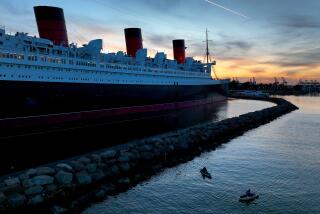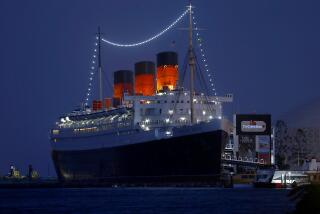QM2 Is New Queen of South Florida
- Share via
PORT EVERGLADES, Fla. — When the Queen Mary 2, the world’s biggest passenger ship, nosed out to sea on its maiden voyage to the Caribbean, along with sun-famished passengers by the hundreds, it carried $600,000 in Florida-bought food and drink, including some hastily purchased beer.
For on the eve of the liner’s departure from this south Florida port, employees on QM2 had an unexpected request to the corporate offices in Miami: beer in plastic bottles for the Super Bowl fans on board.
Rolf Hensche, director of procurement and logistics for Cunard Line, was able to rustle up three pallets of the brew and have them loaded before QM2 sailed for San Juan, Puerto Rico. It was a last-minute improvisation in a logistical ballet that was unmatched in scale because of the vessel’s size.
Cunard’s new queen is the longest, tallest, widest, largest and costliest passenger ship ever built -- and its launch is a welcome boost to the economy of south Florida.
The entry into service of the $800-million Queen Mary 2 is also a milestone in an industry that lived through anxious times after the Sept. 11 terrorist attacks, when Americans became skittish about flying and travel in general, and that has kept itself afloat by offering widespread discounts.
But the decision to base the British-registered vessel in a Florida port during winter also highlights the state’s dominant position in the cruise industry, and the multibillion-dollar payback.
“We are the capital of the cruise industry,” said Alia Faraj, a spokeswoman for Gov. Jeb Bush. “And we will continue to aggressively reach out to attract cruise lines.”
In 2002, the most recent year for which figures are available, two-thirds of the 6.5 million passengers boarding cruise ships in the United States did so at a Florida port, according to the International Council of Cruise Lines, an industry association. The three busiest cruise ship ports in the country were in Miami, Port Everglades (Fort Lauderdale) and Port Canaveral east of Orlando. Vessels from 14 companies used Florida ports.
The Sunshine State accounted for 126,000 jobs, or 45% of those created by the cruise industry in this country in 2002. That same year, cruise ship companies spent $4.5 billion in Florida to acquire everything from fresh strawberries and carpeting to fuel and engine parts, according to industry estimates.
“When it comes to economic impact, Florida is definitely the cruise capital of the United States,” said Christine Fischer, director of communications for the International Council of Cruise Lines. California, she said, is a distant second.
Each winter, the black-hulled, rakish-prowed Queen Mary 2 is expected to generate $2.5 million in hotel, restaurant and taxi business in the greater Fort Lauderdale area.
Florida suppliers will have the opportunity to slake the thirst not only of QM2’s 2,620 passengers, but of the vessel itself. Before casting off for the Caribbean, the liner gulped down 12,000 tons of marine gas oil, 2,500 tons of heavy fuel oil and 2,400 tons of water.
“It has the residual effect of creating jobs for shore staff, line handlers, entertainers, taxis, buses, the provisioners, the people who supply the eggs, the lobsters, the bread, the milk, everything consumed on the ship,” said Ellen Kennedy, communications manager for Port Everglades.
The QM2, which measures 1,132 feet stem to stern, longer than the Library Tower in downtown Los Angeles is tall, arrives toward the tail end of a building boom for U.S.-based cruise lines, which are expected to add a dozen ships to their fleets this year. Those additions will cap an aggressive five-year construction program totaling 62 new vessels.
“We’ve introduced so many ships in the past five years that it is almost equal to what the whole fleet was in the ‘90s,” said Bob Sharak, executive vice president of the Cruise Lines International Assn., an industry marketing arm.
Meanwhile, Sharak said, consumer demand keeps growing. Even with the drop-off in business right after the terrorist attacks on the World Trade Center and the Pentagon, the number of passengers sailing from U.S. and Canadian ports has increased by an annual average of 8.4% since 1980. The association estimates that North American departures will reach 10.6 million people this year.
“We’re putting all these new products out there, adding new ships, and they are sailing full,” Sharak said.
Ships are also becoming bigger. In fact, QM2 will be the world’s largest passenger vessel only for a year or so, until completion of Royal Caribbean’s Ultra Voyager, intended to carry 3,600 passengers.
Analysts say the larger vessels should help Florida preserve its dominance in the face of another industry trend: scheduling departures from ports closer to passengers’ homes. Half the U.S. population now lives within driving distance of a port served by a cruise ship. The benefits to the industry and consumer from bringing ships closer to customers are multiple: convenience, saving on the price of an air ticket and, for people nervous about flying, the chance to go on a cruise without having to take a plane.
“Cruise lines are taking ships out of Florida and sending them to Galveston and New Orleans,” said Oivind Mathisen, editor of Cruise Industry News, a trade publication. “But the ships being taken out are being replaced with bigger ships. So the cruise lines are not really taking away from Florida.”
Like liners during the golden age of transatlantic crossings, the Queen Mary 2 boasts a teak promenade deck, a ballroom for dancing and kennels for pets traveling with their owners. But Cunard’s newest addition also has a 24-hour pizzeria, a Canyon Ranch spa complete with cascading waterfall, and a bridge so highly computerized that the ship can be steered with a videogame-like joystick.
The liner is 112.5 feet longer than its celebrated namesake, now a hotel and tourist attraction in Long Beach. The old liner’s whistle, a deep bass growl two octaves below middle C, was installed aboard QM2.
“Compared to the original Queen Mary, this is much more elaborate,” Bernerd Garsen, a commercial actor, told other champagne-sipping guests in an Art Deco bar on the new liner. “It’s three times better, the top of the line.”
Garsen, 45, said he attended senior prom on the old Queen Mary with San Pedro High’s Class of ’76. He was one of 1,800 guests aboard the QM2 in Port Everglades last Friday for a black-tie benefit for fine arts causes.
According to cruise industry analysts, many companies held on after Sept. 11 by cutting prices and undertaking vigorous and well-publicized actions to deter a terrorist attack at sea. Some smaller lines went bankrupt.
“In the past five years, there has been so much bad publicity with pollution suits, Norwalk virus on board, bad news about ships such as the explosion on the Norway,” said Mike Driscoll, editor of Cruise Week, an industry newsletter. The launch of the QM2 “is a shot in the arm for the industry” in Florida and beyond, he said.
“It gets people thinking about a cruise,” Driscoll said. “They look outside when it’s zero degrees in January, snow on the ground, and they think of getting away somewhere warm.”
*
(BEGIN TEXT OF INFOBOX)
Bon voyage
Florida handled the most embarkations in 2002, with 4.4 million cruisers. Port Canaveral and Port Everglades led the way in growth, with increases of more than 10%.
*--* 2002 2001 passengers passengers Miami 1,821,000 1,700,000 Port Canaveral 1,197,000 1,065,000 Port Everglades 1,105,000 983,000 Tampa 290,000 271,000 Florida 4,413,000 4,019,000 Los Angeles 538,000 500,000 San Francisco 32,000 40,000 San Diego 135,000 103,000 California 705,000 643,000 New York 326,000 238,000 Other U.S. ports 1,056,000 1,000,000 U.S. total 6,500,000 5,900,000
*--*
Source: International Council of Cruise Lines
More to Read
Sign up for The Wild
We’ll help you find the best places to hike, bike and run, as well as the perfect silent spots for meditation and yoga.
You may occasionally receive promotional content from the Los Angeles Times.






